The Preclinical MRI Equipment Market is estimated to be valued at USD 1156.0 million in 2025 and is projected to reach USD 2274.1 million by 2035, registering a compound annual growth rate (CAGR) of 7.0% over the forecast period.
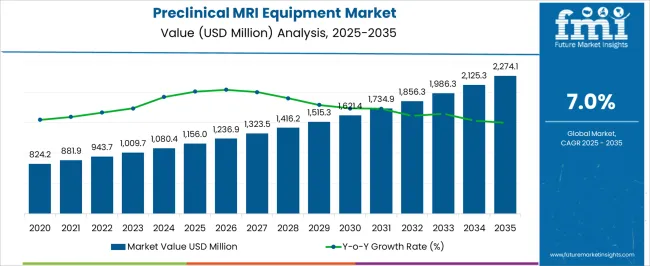
| Metric | Value |
|---|---|
| Preclinical MRI Equipment Market Estimated Value in (2025 E) | USD 1156.0 million |
| Preclinical MRI Equipment Market Forecast Value in (2035 F) | USD 2274.1 million |
| Forecast CAGR (2025 to 2035) | 7.0% |
The Preclinical MRI Equipment market is witnessing substantial growth due to the increasing importance of advanced imaging technologies in drug discovery, biomedical research, and disease modeling. Preclinical MRI equipment offers non-invasive and high-resolution imaging, enabling researchers to study disease progression, evaluate treatment efficacy, and perform longitudinal studies without harming animal subjects. Rising investments in pharmaceutical research, coupled with the need for early-stage drug validation, are fueling adoption.
Technological innovations, such as higher magnetic field strengths, faster acquisition times, and enhanced image reconstruction capabilities, are further enhancing system performance. Moreover, integration of MRI with complementary modalities such as PET or CT is providing more comprehensive insights into molecular and functional processes. Academic institutes, pharmaceutical companies, and research organizations are expanding their infrastructure to accommodate sophisticated imaging tools that accelerate translational research.
Additionally, regulatory bodies emphasize data reproducibility and precision in preclinical studies, supporting the adoption of advanced MRI systems As precision medicine gains prominence and the need for effective preclinical research intensifies, the market for preclinical MRI equipment is expected to maintain robust momentum, driven by innovation and expanding research applications.
The preclinical mri equipment market is segmented by modality, application, retail end user, and geographic regions. By modality, preclinical mri equipment market is divided into Bench Top Preclinical MRI Equipment and Standalone Preclinical MRI Equipment. In terms of application, preclinical mri equipment market is classified into Oncology, Cardiology, Neurology, Inflammatory And Infectious Diseases, and Others. Based on retail end user, preclinical mri equipment market is segmented into Academic And Research Institutes, Biotechnology And Pharmaceutical Companies, Diagnostic Centers, and Contract Research Organizations. Regionally, the preclinical mri equipment industry is classified into North America, Latin America, Western Europe, Eastern Europe, Balkan & Baltic Countries, Russia & Belarus, Central Asia, East Asia, South Asia & Pacific, and the Middle East & Africa.
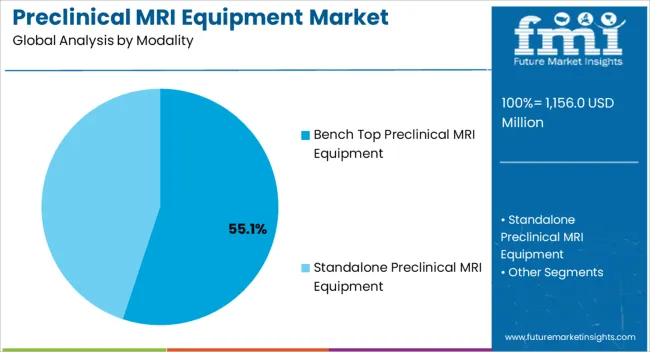
The bench top preclinical MRI equipment segment is projected to account for 55.1% of the market revenue share in 2025, positioning it as the leading modality. This dominance is driven by the segment’s compact design, lower installation costs, and operational efficiency compared to traditional large-scale MRI systems. Bench top systems are favored by academic and small-scale research institutes for their ability to deliver high-resolution imaging in limited laboratory spaces.
Advances in magnet technology, along with software-driven enhancements in imaging speed and accuracy, have reinforced the preference for bench top solutions. Their scalability and cost-effectiveness make them particularly attractive for institutions conducting a high volume of preclinical studies. Additionally, the integration of advanced imaging software enables researchers to perform detailed analyses and longitudinal monitoring with greater ease.
The versatility of bench top MRI systems in applications ranging from oncology to neuroscience is further supporting market expansion As demand for efficient and space-saving imaging solutions continues to rise, the bench top segment is expected to sustain its leadership, supported by strong adoption across global research facilities.
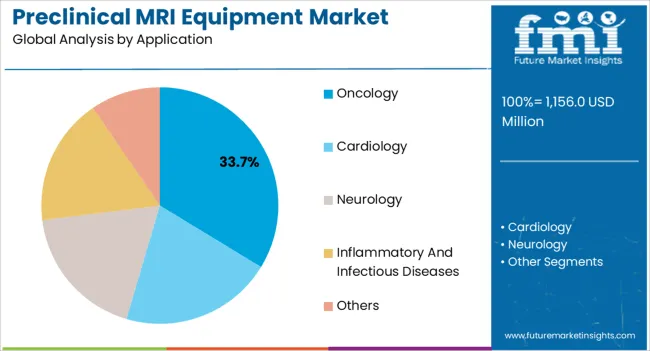
The oncology application segment is expected to capture 33.7% of the market revenue share in 2025, making it the largest application area. Growth is being driven by the rising global incidence of cancer and the urgent need for precise preclinical models to evaluate new therapies. Preclinical MRI plays a critical role in oncology research by providing high-resolution visualization of tumor progression, angiogenesis, and treatment response.
Non-invasive imaging capabilities allow for longitudinal studies that reduce animal usage while improving data reproducibility. Furthermore, the ability to combine MRI with molecular imaging modalities enhances insights into tumor biology and therapeutic mechanisms. Pharmaceutical and biotechnology companies are increasingly adopting preclinical MRI to accelerate oncology drug discovery and optimize clinical trial success rates.
Academic institutions also rely heavily on these systems to advance cancer biology research The growing demand for personalized therapies and targeted drug delivery solutions further reinforces the importance of oncology applications With sustained investments in cancer research and the continuous evolution of imaging technologies, this segment is expected to maintain its dominant role in the preclinical MRI equipment market.
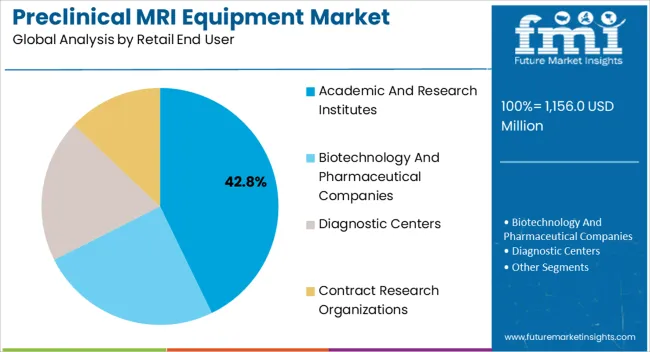
The academic and research institutes segment is anticipated to hold 42.8% of the market revenue share in 2025, establishing itself as the leading end user category. Academic institutions play a pivotal role in advancing biomedical research, and preclinical MRI systems have become essential tools for their scientific investigations. These institutes rely on advanced imaging equipment to explore disease mechanisms, test novel therapeutics, and publish reproducible findings that contribute to global medical knowledge.
Bench top MRI systems, in particular, are well suited for academic laboratories due to their affordability, compact design, and ease of use. Additionally, collaborations between universities and pharmaceutical companies are further boosting demand, as shared research facilities increasingly deploy MRI for translational studies. Government grants and funding for academic research are supporting infrastructure expansion and modernization, strengthening this segment’s leadership.
Moreover, training and educational programs on imaging technologies are creating skilled researchers who drive adoption As the global emphasis on biomedical innovation intensifies, academic and research institutes are expected to remain the largest end user, fostering continuous growth for preclinical MRI equipment.
Currently, non-invasive and in-vivo imaging modalities have become quite popular in the study of animal models longitudinally. Preclinical imaging is a non-invasive technique used to visualize living animals in order to study various diseases quantitatively, in real time, with the ability to monitor the disease progression rate at molecular level.
Suitable models for preclinical in-vivo studies include, positron emission tomography scanners (PET), single photon emission tomography scanners (SPECT), ultrasound, magnetic resonance imaging (MRI), compute tomography etc.
Preclinical MRI imaging technique employs use of large magnets that help generating magnetic fields, carefully targeted electromagnetic pulses, and computer software in order to obtain organ level anatomical images with high spatial resolution.
These generated magnetic fields results in formation of paramagnetic atoms including hydrogen, gadolinium, and manganese created by the radiofrequency (RF) coils inside the MRI machine. The machine then captures the relaxation of the atoms at the time when the RF pulse is ceased thus generating an image based on the resonance characteristic of the body part being studied.
The preclinical MRI equipment’s are used in study of various life threatening disorders including cancer, cardiovascular disorders, neurological and infectious and inflammatory diseases etc. Apart from this the device can also be used in the transitional research and new drug development.
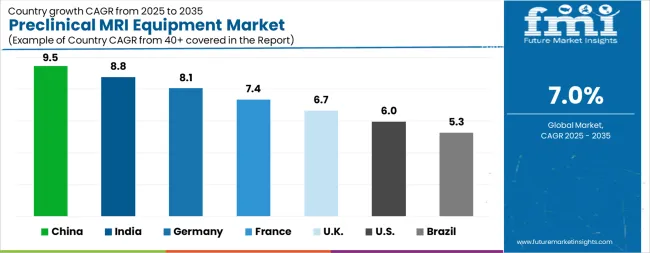
| Country | CAGR |
|---|---|
| China | 9.5% |
| India | 8.8% |
| Germany | 8.1% |
| France | 7.4% |
| UK | 6.7% |
| USA | 6.0% |
| Brazil | 5.3% |
The Preclinical MRI Equipment Market is expected to register a CAGR of 7.0% during the forecast period, exhibiting varied country level momentum. China leads with the highest CAGR of 9.5%, followed by India at 8.8%. Developed markets such as Germany, France, and the UK continue to expand steadily, while the USA is likely to grow at consistent rates. Brazil posts the lowest CAGR at 5.3%, yet still underscores a broadly positive trajectory for the global Preclinical MRI Equipment Market. In 2024, Germany held a dominant revenue in the Western Europe market and is expected to grow with a CAGR of 8.1%. The USA Preclinical MRI Equipment Market is estimated to be valued at USD 419.2 million in 2025 and is anticipated to reach a valuation of USD 747.1 million by 2035. Sales are projected to rise at a CAGR of 6.0% over the forecast period between 2025 and 2035. While Japan and South Korea markets are estimated to be valued at USD 61.8 million and USD 32.4 million respectively in 2025.
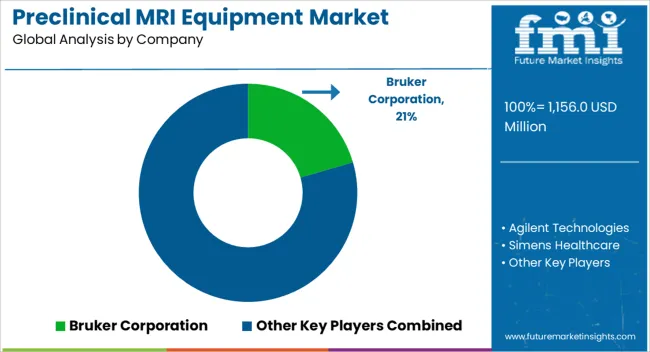
| Item | Value |
|---|---|
| Quantitative Units | USD 1156.0 Million |
| Modality | Bench Top Preclinical MRI Equipment and Standalone Preclinical MRI Equipment |
| Application | Oncology, Cardiology, Neurology, Inflammatory And Infectious Diseases, and Others |
| Retail End User | Academic And Research Institutes, Biotechnology And Pharmaceutical Companies, Diagnostic Centers, and Contract Research Organizations |
| Regions Covered | North America, Europe, Asia-Pacific, Latin America, Middle East & Africa |
| Country Covered | United States, Canada, Germany, France, United Kingdom, China, Japan, India, Brazil, South Africa |
| Key Companies Profiled | Bruker Corporation, Agilent Technologies, Simens Healthcare, Aspect Imaging, FUJIFILM Holdings Corporation, MR Solutions Ltd, Perkin Elmer, Inc, and Mediso Medical Imaging Systems |
The global preclinical MRI equipment market is estimated to be valued at USD 1,156.0 million in 2025.
The market size for the preclinical MRI equipment market is projected to reach USD 2,274.1 million by 2035.
The preclinical MRI equipment market is expected to grow at a 7.0% CAGR between 2025 and 2035.
The key product types in preclinical MRI equipment market are bench top preclinical MRI equipment and standalone preclinical MRI equipment.
In terms of application, oncology segment to command 33.7% share in the preclinical MRI equipment market in 2025.






Our Research Products

The "Full Research Suite" delivers actionable market intel, deep dives on markets or technologies, so clients act faster, cut risk, and unlock growth.

The Leaderboard benchmarks and ranks top vendors, classifying them as Established Leaders, Leading Challengers, or Disruptors & Challengers.

Locates where complements amplify value and substitutes erode it, forecasting net impact by horizon

We deliver granular, decision-grade intel: market sizing, 5-year forecasts, pricing, adoption, usage, revenue, and operational KPIs—plus competitor tracking, regulation, and value chains—across 60 countries broadly.

Spot the shifts before they hit your P&L. We track inflection points, adoption curves, pricing moves, and ecosystem plays to show where demand is heading, why it is changing, and what to do next across high-growth markets and disruptive tech

Real-time reads of user behavior. We track shifting priorities, perceptions of today’s and next-gen services, and provider experience, then pace how fast tech moves from trial to adoption, blending buyer, consumer, and channel inputs with social signals (#WhySwitch, #UX).

Partner with our analyst team to build a custom report designed around your business priorities. From analysing market trends to assessing competitors or crafting bespoke datasets, we tailor insights to your needs.
Supplier Intelligence
Discovery & Profiling
Capacity & Footprint
Performance & Risk
Compliance & Governance
Commercial Readiness
Who Supplies Whom
Scorecards & Shortlists
Playbooks & Docs
Category Intelligence
Definition & Scope
Demand & Use Cases
Cost Drivers
Market Structure
Supply Chain Map
Trade & Policy
Operating Norms
Deliverables
Buyer Intelligence
Account Basics
Spend & Scope
Procurement Model
Vendor Requirements
Terms & Policies
Entry Strategy
Pain Points & Triggers
Outputs
Pricing Analysis
Benchmarks
Trends
Should-Cost
Indexation
Landed Cost
Commercial Terms
Deliverables
Brand Analysis
Positioning & Value Prop
Share & Presence
Customer Evidence
Go-to-Market
Digital & Reputation
Compliance & Trust
KPIs & Gaps
Outputs
Full Research Suite comprises of:
Market outlook & trends analysis
Interviews & case studies
Strategic recommendations
Vendor profiles & capabilities analysis
5-year forecasts
8 regions and 60+ country-level data splits
Market segment data splits
12 months of continuous data updates
DELIVERED AS:
PDF EXCEL ONLINE
Preclinical Ultrasound Systems Market Size and Share Forecast Outlook 2025 to 2035
Preclinical CRO Market Size and Share Forecast Outlook 2025 to 2035
Preclinical Medical Device Testing Services Market Analysis - Size, Growth, & Forecast Outlook 2025 to 2035
Market Leaders & Share in the Preclinical Medical Device Testing Services Industry
Preclinical Imaging Market
UK Preclinical Medical Device Testing Services Market Outlook – Share, Growth & Forecast 2025-2035
China Preclinical Medical Device Testing Services Market Insights – Trends, Demand & Growth 2025-2035
India Preclinical Medical Device Testing Services Market Report – Trends & Innovations 2025-2035
Germany Preclinical Medical Device Testing Services Industry Analysis from 2025 to 2035
United States Preclinical Medical Device Testing Services Market Trends – Growth, Demand & Analysis 2025-2035
MRI-Guided Cardiac Ablation Market Size and Share Forecast Outlook 2025 to 2035
MRI-based Quantitative Biomarkers Market Analysis - Size, Share, and Forecast Outlook 2025 to 2035
MRI Pulse Oximeters Market Size and Share Forecast Outlook 2025 to 2035
MRI Transport Market Size and Share Forecast Outlook 2025 to 2035
MRI Compatible Patient Monitoring Systems Market Size and Share Forecast Outlook 2025 to 2035
MRI-Safe CRT Devices Market Size and Share Forecast Outlook 2025 to 2035
MRI Guided Neurosurgical Ablation Market Insights - Demand & Growth 2025 to 2035
MRI-Compatible IV Infusion Pump Systems Market Growth – Trends & Forecast 2025-2035
MRI-Safe Neurostimulation Systems Market Growth - Trends & Forecast 2025 to 2035
MRI Safe Biopsy Needle Market

Thank you!
You will receive an email from our Business Development Manager. Please be sure to check your SPAM/JUNK folder too.
Chat With
MaRIA